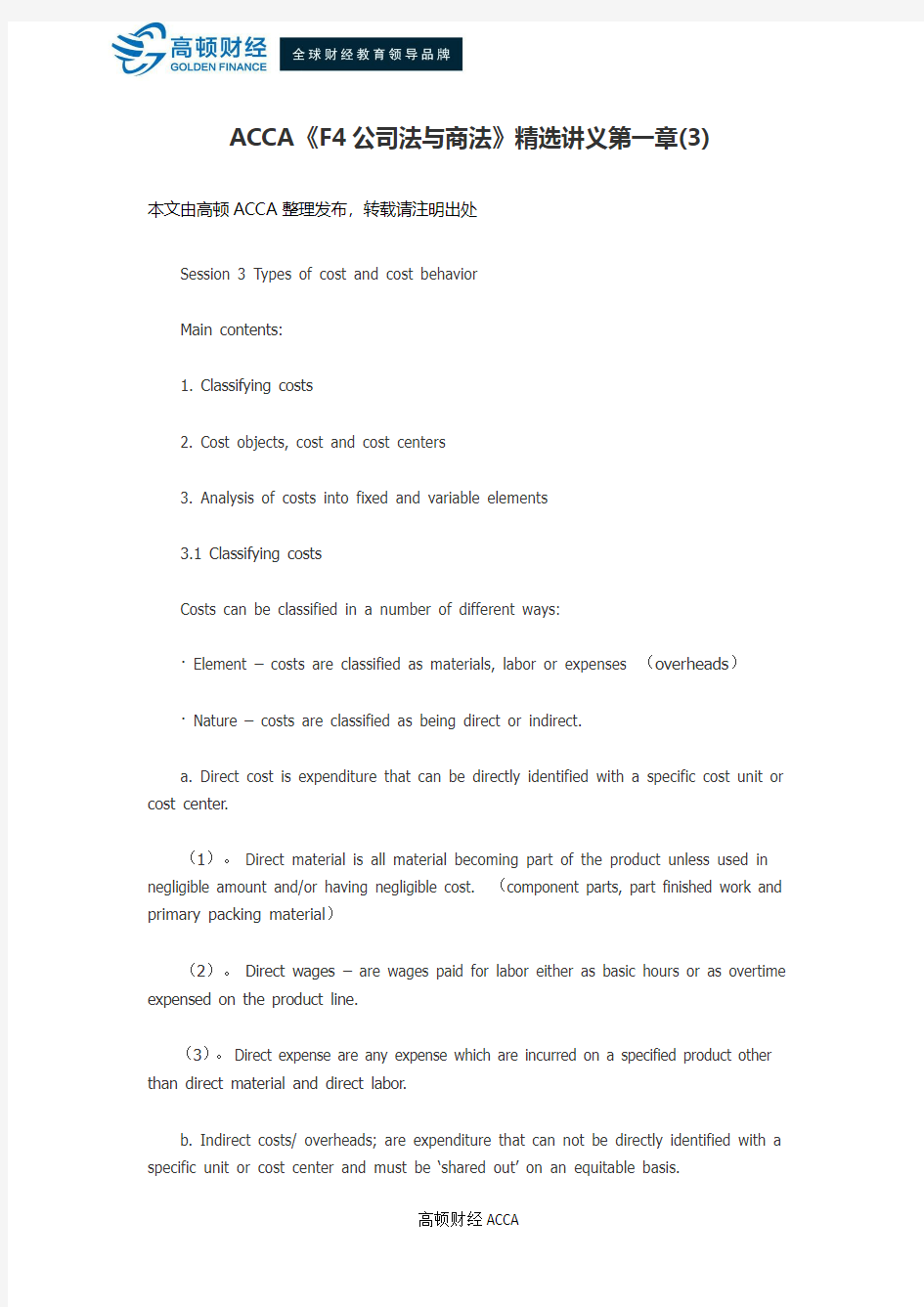ACCA《F4公司法与商法》精选讲义第一章(3)


ACCA《F4公司法与商法》精选讲义第一章(3)
本文由高顿ACCA整理发布,转载请注明出处
Session 3 Types of cost and cost behavior
Main contents:
1. Classifying costs
2. Cost objects, cost and cost centers
3. Analysis of costs into fixed and variable elements
3.1 Classifying costs
Costs can be classified in a number of different ways:
· Element – costs are classified as materials, labor or expenses (overheads)
· Nature – costs are classified as being direct or indirect.
a. Direct cost is expenditure that can be directly identified with a specific cost unit or cost center.
(1)。Direct material is all material becoming part of the product unless used in negligible amount and/or having negligible cost. (component parts, part finished work and primary packing material)
(2)。Direct wages – are wages paid for labor either as basic hours or as overtime expensed on the product line.
(3)。Direct expense are any expense which are incurred on a specified product other than direct material and direct labor.
b. Indirect costs/ overheads; are expenditure that can not be directly identified with a specific unit or cost center and must be ‘shared out’ on an equitable basis.
· Behavior –costs are classified as being fixed, variable, semi-variable or stepped fixed.
a. Fixed costs: are costs that are not affected in total by the level of activity, but remain the same.
b. Variable costs: are the costs that change in total in direct proportion to the level of activity.
c. Semi-variable/semi-fixed/mixed costs: are costs which contain both fixed and variable components and so it partly affected by changes in the level of activity.
d. Step costs: are fixed in nature but only within certain level of activity.
· Function: costs are classified as being production or non-production costs.
e. Production costs: are costs included in a stock valuation. The product cost is the cost of making or buying.
f. Period costs (general cost):are costs that are not attributed to product costs, but instead are treated as a cost of the time period when they arise.
· Other cost classification:
Avoidable cost: cost which can be eliminated by changing operations
Unavoidable cost: cost which will not be changed by decision making.
Controllable cost: those cost controllable by a particular manager in a given period.
Uncontrollable cost: any cost that can not be affected by management within a given period.
COST MODEL: $
Direct material: 2
Direct labor 3
Direct expense 1Direct cost 6
Production overhead (Note)1
Total production cost 7
Administration Overhead 1
Selling and distribution Overhead 1Total cost 9
Note: Production overhead includes indirect material, indirect labor and indirect expense.
3.2 Analyzing costs:
Cost objects: a cost object is any activity for which a separate measurement of cost is undertaken.
Cost units: a cost unit is a unit of product or service in relation to which costs are ascertained
Responsibility centers: a department whose performance is the direct responsibility of a specific manager.
The main responsibility centers are:
· Cost center – the performance of a cost center manager is judged on the extent to which cost targets have been achieved.
· Revenue center – Within an organization, this is a centre or activity that earns sales revenue. And whose manager is responsible for the revenue earned but not for the costs incurred.
· Profit center – a part of the business whose manager is responsible and accountable for both costs and revenue. The performance of a profit center manager is measured in terms of the profit made by the centre.
· Investment centre – a profit centre with additional responsibility for investment and possibly also for financing, and whose performance is measured by its return on capital employed.
(ROCE)。
Cost equations:
Equation of a straight line
The equation of a straight line is a linear function and is represented by the following equation:
Y = a + bx
Total cost = Total FC + Total VC
Y= a + bx
· Y = total cost
· a = the fixed cost for the given period
· b = the variable cost per unit
· x = the number of units of activity
Cost graphs
Cost and revenue $
更多ACCA资讯请关注高顿ACCA官网:https://www.360docs.net/doc/a97888519.html,
